What’s the Triumph Tiger Explorer got the BMW R1200GS does not? One cylinder and about 50 more pounds of wet weight. At least that’s what we can deduce at this juncture having ridden the two bikes separately but not yet directly compared them.
This will change soon, however, as our annual trek to Laguna Seca for MotoGP includes these two machines, a Yamaha Super Ténéré, Moto Guzzi Stelvio NTX and KTM 990 Adventure. Hundreds of miles of off-road, freeway and twisty pavement will ensue, and we’ll even spend a night camping in the Sierra Mountains. But for now, here’s our take on Triumph’s newest big-bore entry into the Adventure-Touring market.
With minimal off-road riding time, this review largely focuses on the Explorer’s on-road competence, which is apropos as bikes of this nature generally traverse more paved than unpaved miles in their lifetimes. We’ll have a better understanding of its off-road performance whence returning from MotoGP, but let’s get this review underway with an element of equal importance to both types of riding – the engine.
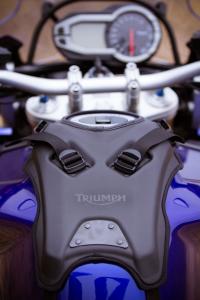 Probably the Explorer’s best attribute is its 1215cc Triple, Triumph’s newest engine powering both it and the forthcoming Trophy SE. Producing a claimed 135 horsepower at 9,000 rpm (500 rpm below redline) and 89 ft-lb of torque at 6,400 rpm, the biggest Tiger in Triumph’s line-up bests its 800cc stablemate by a claimed 41 hp and 31 more claimed ft-lb of torque. Like the Tiger 800, the Explorer’s mill produces gobs of low- and mid-range grunt in a vibration-free power delivery but with more arm-yanking urgency than the 800.
Probably the Explorer’s best attribute is its 1215cc Triple, Triumph’s newest engine powering both it and the forthcoming Trophy SE. Producing a claimed 135 horsepower at 9,000 rpm (500 rpm below redline) and 89 ft-lb of torque at 6,400 rpm, the biggest Tiger in Triumph’s line-up bests its 800cc stablemate by a claimed 41 hp and 31 more claimed ft-lb of torque. Like the Tiger 800, the Explorer’s mill produces gobs of low- and mid-range grunt in a vibration-free power delivery but with more arm-yanking urgency than the 800. Control of that power is transmitted to the ECU via a ride-by-wire throttle, and while the system seems to work with modern efficiency, it’s also home to the Explorer’s most glaring defect; a ridiculously light throttle return spring. Lacking the proper tension, even the most steady-handed rider cannot stop mild road imperfections from causing movements in the throttle which the engine responds to by minor increases and decreases in speed. Off-road riding, with its coarse topography, will exacerbate this effect.Like BMW’s Paralever design, the Explorer employs a shaft drive with a torsional damping system via a sprung bevel gear in order to maintain the bike’s designed geometric arrangement. To further reduce the adverse effects brought about by a shaft-driven rear wheel, Triumph explains that the shaft is “a two-part ‘metalistic’ shaft, which means that a rubber component sits between two separate shafts to deliver a smoother riding experience.”
The Tiger Explorer is rife with rider aids including cruise control, anti-lock brakes (ABS) and traction control (TC). The simple pleasure of removing your right hand from the grip to stretch and restore blood flow that cruise control offers is worth the admission price. Selectable in 1-mph increments, a rider can choose the exact speed he wishes to travel, take a breather and enjoy the scenery.
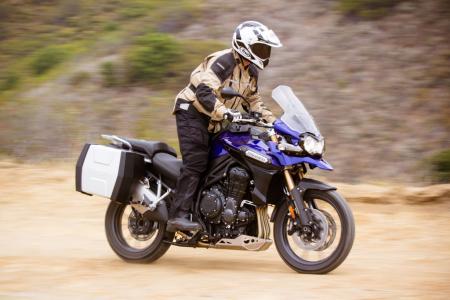 Our Tiger Explorer test mule was outfitted with Triumph accessories including TDLS panniers, alloy bash plate, two-stage heated rider and passenger seats, two-stage heated hand grips, tank bag (not shown). Grand total: $2,150. Our Tiger Explorer test mule was outfitted with Triumph accessories including TDLS panniers, alloy bash plate, two-stage heated rider and passenger seats, two-stage heated hand grips, tank bag (not shown). Grand total: $2,150. |
Both ABS and TC are switchable, the ABS for on/off and TC with a choice of two positions (#1 more intrusive, #2 less intrusive) and off. Both functions are controlled via left handlebar button operations and visible on the digital instrument cluster. The ABS isn’t as easy as the BMW’s to disengage but it’s not rocket science and with a few practice runs you’ll have the process mastered. Both functions default to “on” whenever the ignition is keyed off.
Other conveniences of the Explorer include a height-adjustable rider seat and position-adjustable handlebars, while a 950-watt generator powers optional two-stage heated seats for both rider ($370) and passenger ($320), optional two-stage heated grips ($200), optional fog lights ($350), the integrated power supply in the optional top box ($440) and the tank-mounted power socket.The Tiger Explorer is available with the same basic optional hard luggage accessories we reported on with the introduction of last year’s Tiger 800 and Tiger 800XC. “The visually rugged saddlebags ($800) are seemingly built to withstand a Dakar-esque get-off, and I liked their lockable, easy-on, easy-off design that will appeal to commuters. But a component is only as strong as its weakest part, and on these saddlebags it’s the attachment point. Twice I witnessed bags break off of fellow journalist bikes during slow-speed, front-end washouts in the dirt. Off-road warriors will wish for more robust mounts.”
While the Explorer’s saddlebags are susceptible to the same easy breakage, the system does boast Triumph’s Dynamic Luggage System (TDLS). In short, the system is said to help maintain chassis balance by allowing each saddlebag to move through a damped five-degree arc. First introduced on the 2004 Sprint ST, the system has, according to Triumph, been advanced during each subsequent iteration and will be present on the forthcoming 2013 Trophy SE.
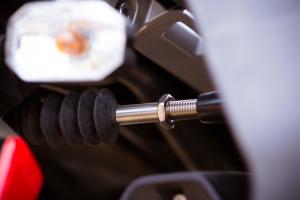 On pavement-only Sprint and Trophy models, the loose attachment of the bags isn’t as noticeable and may provide some of the performance benefits Triumph claims, but on the off-road Tiger models the system allows the luggage to bang around noisily and break off easily which negates any perceivable advantage the system might provide on the street.
On pavement-only Sprint and Trophy models, the loose attachment of the bags isn’t as noticeable and may provide some of the performance benefits Triumph claims, but on the off-road Tiger models the system allows the luggage to bang around noisily and break off easily which negates any perceivable advantage the system might provide on the street.Another technical option available on the Tiger Explorer is Triumph’s Tire Pressure Monitoring System (TPMS) ($160) that displays air pressure for both front and rear wheels on the 2 x 2.5-inch LCD instrument screen. The instrument cluster also includes a digital speedometer, analog tachometer, gear-position indicator, fuel gauge, range to empty, service indicator, clock, air temperature, frost warning, hazard warning lights and trip computer.Tire sizes of 110/80-19 front and 150/70-17 rear equal that of the GS, while the Explorer’s inverted, preload-adjustable 46mm fork boasts 7.48 inches of travel. The Kayaba rear monshock has 7.63 inches of travel and features a remote oil reservoir, rebound adjustment and preload adjustment from a conveniently located twist knob next to the rider’s right leg. Other niceties include removable rubber inserts inside the footpegs, a centerstand and 90-degree valve stems.
Time spent aboard the Explorer can be described as comfortable, including rider ergonomics (seat in the high position for those taller than 5’ 10”), windflow from the non-adjustable windscreen, and the optional two-stage heated seat installed on our test bike. For 2012 the Tiger Explorer is available in Phantom Black, Graphite and Sapphire Blue.
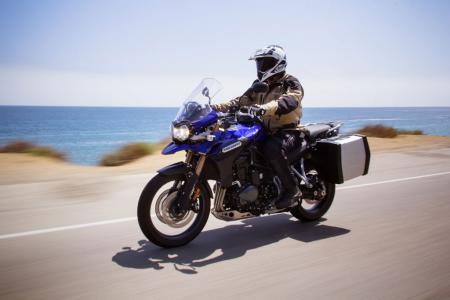 An expression often associated with GSX-Rs but also befitting the Explorer is that a rider sits into the Triumph. An adjustable stock seat plus optional 'low' and 'high' seats allow comfort customization. An expression often associated with GSX-Rs but also befitting the Explorer is that a rider sits into the Triumph. An adjustable stock seat plus optional 'low' and 'high' seats allow comfort customization. |
Is the new Tiger Explorer worth its $15,700, non-accessorized asking price? Possibly. It’s more expensive than Yamaha’s Super Ténéré ($14,500) but less than BMW’s R1200GS ($16,150) so it’s appropriately priced. In a few weeks we’ll have a definite answer as to which bike we prefer. Compared to the 800cc Tigers, the Explorer is more bike, but the lighter, more manageable size of the Tiger 800 and 800XC will get you into and out of more precarious off-road predicaments, leaving you to decide if you require a bike that’s more touring or one that’s more off-road adventurous.
| By the Numbers | |
| Price | $15,699 |
| Engine Type | Inline Triple |
| Displacement | 1215cc |
| Bore x Stroke | 85mm x 71.4mm |
| Horsepower | 135 hp (claimed) |
| Torque | 89 ft-lbs (claimed) |
| Frame | Tubular steel trellis frame |
| Wheelbase | 60.2" |
| Rake/Trail | 23.9-degrees/105.5mm |
| Front Suspension | Kayaba 46mm USD Forks w/190mm travel |
| Rear Suspension | Kayaba monoshock with remote oil reservoir, hydraulically adjustable preload, rebound damping w/194mm travel |
| Front/Rear Wheels | 19-inch/17-inch cast aluminum alloy |
| Tires | 110/80 x 19 Front, 150/70 x 18 Rear |
| Front Brakes | Twin 305mm floating discs, Nissin 4-pistons caliper, switchable ABS |
| Rear Brakes | Single 282mm disc, Nissin 2-piston sliding caliper, switchable ABS |
| Fuel Capacity | 5.3 U.S. gal |
| Wet Weight | 570 pounds |
| Seat Height | Adjustable from 32.9" to 33.7" |



 10:17 PM
10:17 PM
 Unknown
Unknown


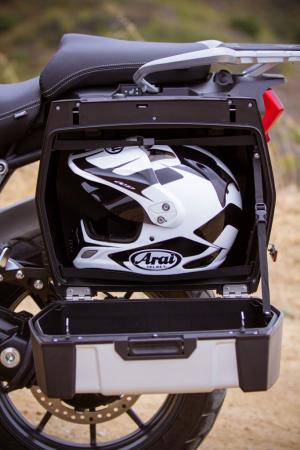
 Posted in:
Posted in: 




0 comments:
Post a Comment